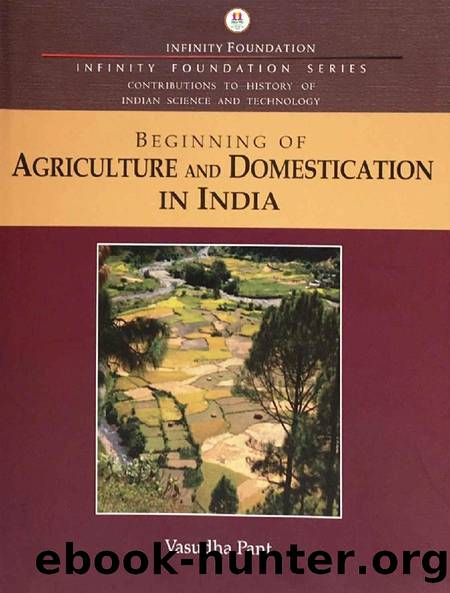Beginning of Agriculture and Domestication in India by Vasudha Pant

Author:Vasudha Pant [Pant, Vasudha]
Language: eng
Format: epub
Publisher: Infinity Foundation India
Published: 2020-11-12T00:00:00+00:00
Farming Tools and Technology
Despite of getting evidences of the advanced cultivation and farming techniques of the farmers of the Indus civilisation during in the third millennium BCE, we do not know much about the agricultural implements and tools that those people used. The large granaries discovered at Harappa and Mohenjodaro clearly indicate that cereals were produced in such a large quantity that those not only met all the needs of the people, but also a buffer stock, stored in large jars/bins in the granaries for any future emergency. Domestic storage bins/jars were made for the storage of grains. The wide distribution of those jars of various sizes may suggest that almost all households had such storage jars in their dwellings. Many such jars were found stacked one over another in one of the rooms at Kalibangan (Lal 1997: 159).
Creation of such large stocks could not have possible without improved farming techniques and equipments, but we hardly know anything reasonable about any of those. Therefore, we have to rely on the circumstantial evidences and indirect inferences about those. The scholars have adopted similar conjectural methodology to find the use of plough by the Indus people. The discovery of ploughed field of the early Indus phase at Kalibangan is one of such instance, which has already been noted in the preceding part. That is the earliest discovery of an agricultural field through archaeological excavation anywhere in the world. However, it may be difficult to generalise it as a common practice over the entire Indus region at this stage. That crisscross pattern of sowing must have required some sort of tool, might be a wooden plough of indeterminate shape.
In following phase, the continuing use of plough in the mature Harappan phase has also been inferred from the terracotta models of ploughs recovered from Kalibangan. That may reasonably be assumed to have been the type of plough used by the early Indus farmers as well. Terracotta models at Bahawalpur and Banavali also give further evidence of the use of that tool (Lal 1998:61). (Fig. 6.25) The fact that no actual plough was recovered from any of the Indus sites may be because those were made of perishable wood. Complete specimen of a terracotta model of plough from the mature Harappan phase at Banavali (Bisht 1993: 113-124) sets at rest all the hypothesis about the use (or non-use) of plough during the Indus time.
Fig. 6.25 Terracotta model of plough from Banavali
At some places, use of canal irrigation has been mentioned, yet the evidence is rather meagre. Except for the indirect inferences, it may be difficult to ascertain the level of advancement in the agricultural tools and technology, like irrigation, plough and other equipments, like rake or a harrow during that period.
It is not possible to ascertain the use farmyard manure in that age. The discovery of traces of gypsum crystals on a potsherd from the Indus site of Kalibangan may be of special interest, but the possibility that the Indus people of the northern Rajasthan used gypsum as a fertiliser is very remote and farfetched.
Download
This site does not store any files on its server. We only index and link to content provided by other sites. Please contact the content providers to delete copyright contents if any and email us, we'll remove relevant links or contents immediately.
| Africa | Americas |
| Arctic & Antarctica | Asia |
| Australia & Oceania | Europe |
| Middle East | Russia |
| United States | World |
| Ancient Civilizations | Military |
| Historical Study & Educational Resources |
The Third Pole by Mark Synnott(915)
Money for Nothing by Thomas Levenson(898)
The Economist (20210109) by calibre(897)
Christian Ethics by Wilkens Steve;(824)
Made in China by Anna Qu(813)
The Age of Louis XIV: The Story of Civilization by Will Durant(789)
Reopening Muslim Minds by Mustafa Akyol(768)
Nonstate Warfare by Stephen Biddle(767)
100 Posters That Changed The World by Salter Colin T.;(751)
Culture by Terry Eagleton(724)
The Shortest History of China by Linda Jaivin(722)
The Great Pyramid Void Enigma by Scott Creighton(721)
The Irish Buddhist by Alicia Turner(720)
Ideology by Eagleton Terry;(696)
Routledge Handbook of Contemporary India by Knut A. Jacobsen(695)
Sybille Bedford by Selina Hastings(656)
The Jews of Silence: A Personal Report on Soviet Jewry by Elie Wiesel(651)
Objects of Vision by Saab A. Joan;(639)
Banaras: CITY OF LIGHT by Diana L. Eck(631)
